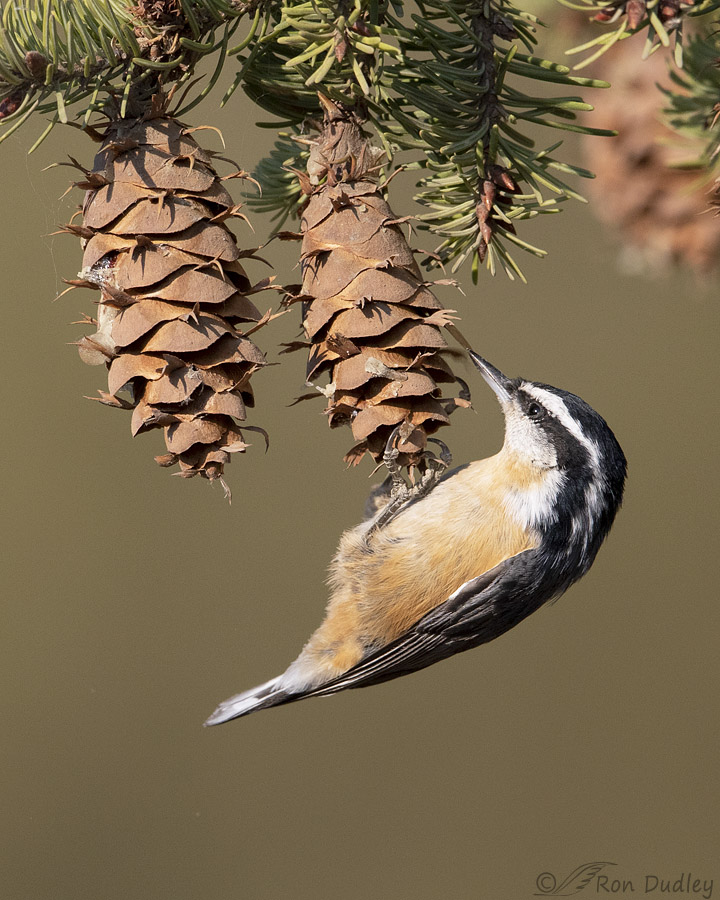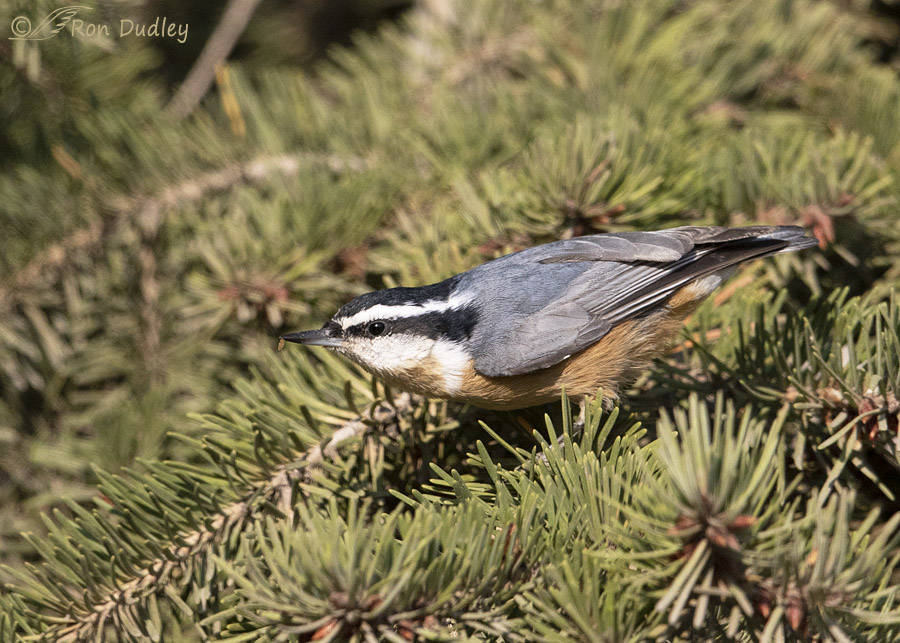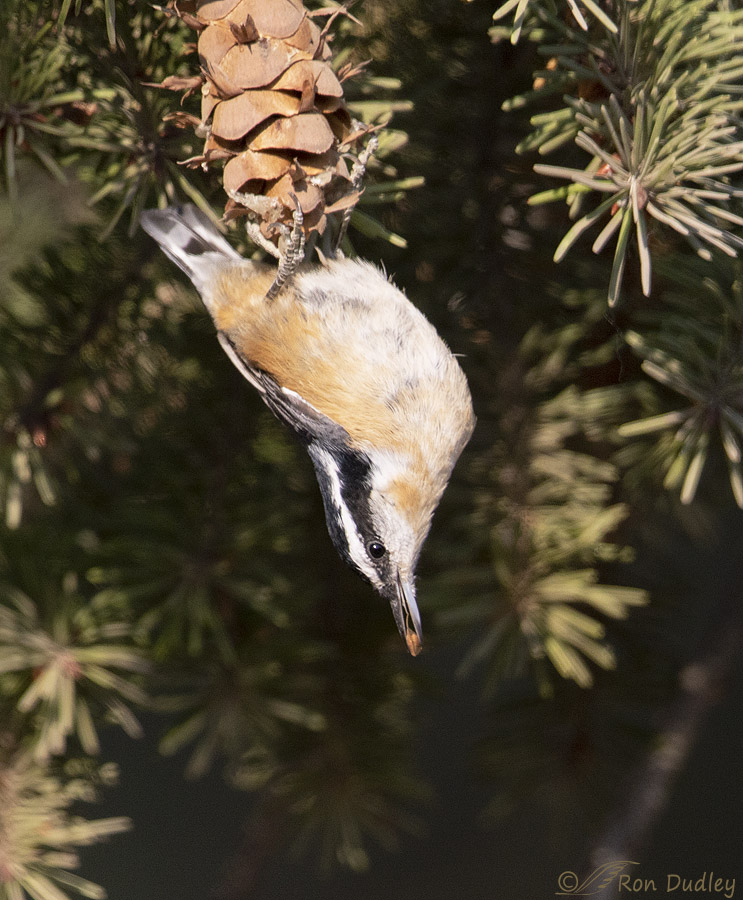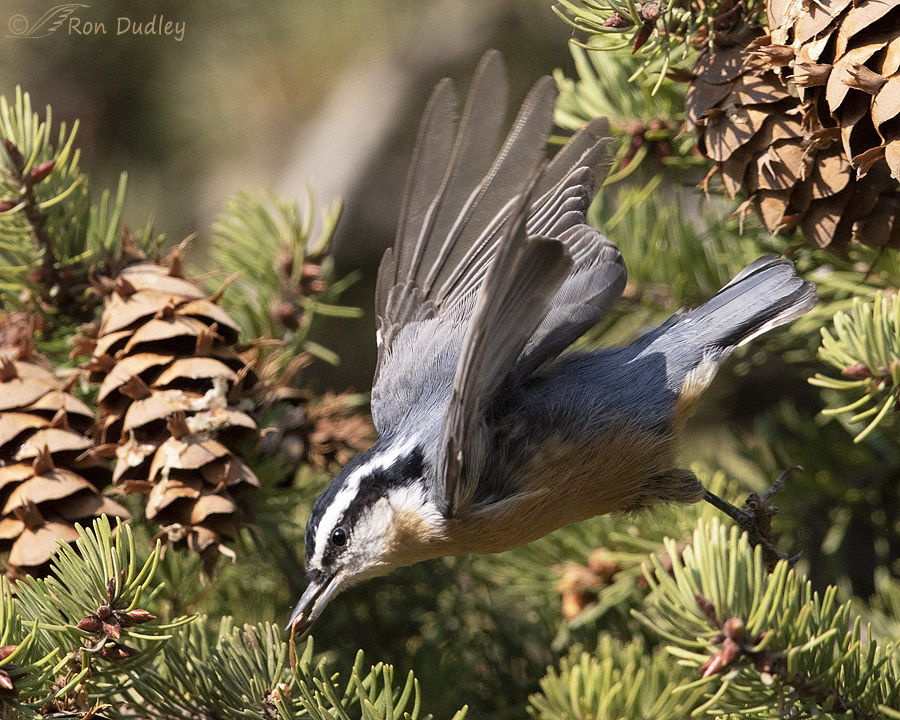A handsome little bird, an interesting behavior and a setting I’ve always loved.

1/2500, f/5.6, ISO 800, Canon 7D Mark II, Canon EF 500mm f/4L IS II USM + EF 1.4 III Extender, not baited, set up or called in
I enjoy photographing birds in Douglas Fir trees because I think it’s an unusually attractive setting, particularly when the current year’s cones are included in the frame. Throw in an interesting feeding behavior and I’m a happy photographer.
Three days ago I spent some time with this male Red-breasted Nuthatch collecting seeds from the cones. Here he’s pulling out one of the cone scales with an attached seed that we can’t see. I was pleased to get the nuthatch in a side view with light in his eye against a clean background and the bird, both primary cones and most of the needles sharp. I can easily live with the out of focus cone at upper right.

1/4000, f/5.6, ISO 800, Canon 7D Mark II, Canon EF 500mm f/4L IS II USM + EF 1.4 III Extender, not baited, set up or called in
He spent most of his time hanging from the cones or moving from one cone to another so I only rarely got photos of him perched on the branches or needles.
It’s almost a novelty to get a photo of a nuthatch that isn’t upside down or pointed straight up on a cone or tree trunk.

1/2000, f/5.6, ISO 800, Canon 7D Mark II, Canon EF 500mm f/4L IS II USM + EF 1.4 III Extender, not baited, set up or called in
He was an incredibly picky eater. I’d estimate that he deliberately dropped nearly half of the seeds he collected. Interestingly there was a group of White-crowned Sparrows beneath the tree that seemed to be foraging for and eating the seeds nuthatches had discarded.
When he had a seed in his bill this completely upside down pose could mean one of two things – he’s either about to drop the seed or he’s about to take off with it to eat or cache it. I always tried to photograph both behaviors, him dropping the seed or taking off with it, but both actions were incredibly quick with unpredictable timing.
In this particular instance he dropped the seed and in the next photo in the burst I caught it falling but it’s a terrible photo of the nuthatch so I haven’t included it.

1/3200, f/5.6, ISO 800, Canon 7D Mark II, Canon EF 500mm f/4L IS II USM + EF 1.4 III Extender, not baited, set up or called in
Even though I tried many times I never did get a great takeoff shot. Nuthatches are just too fast and there’s too many things that can and do go wrong. Here his head isn’t quite sharp enough and I don’t have enough room at the bottom of the frame for a composition I like. But I count this shot as a minor success if only because I didn’t clip or cut off any body parts.
When it comes to quality takeoff or flight shots these birds are a tough nut(hatch) to crack.
Ron
Note: I believe all of these photos are of the same bird but I can’t be sure.


These are wonderful…what I appreciate most is that your super photos freezes the action of these fast little guys so that I can see the detail I usually miss…
Thank you, Patty – one of the little miracles of photography.
The cones themselves are interesting subjects as is your description of their foraging habits. If it were not for COVID I probably would have been watching them as they arrive in Illinois. Their numbers during migration fluctuate considerably, perhaps related to the amount and timing of the cone supply.
I agree, Kenneth – I love those cones in my bird photos.
When even Captain Picky is happy I know before I start to look I will be delighted. And delighted I am.
Ha, ‘Captain Picky’ – I believe that’s a new one, EC. 🙂
Accurate though.
🙂
LOVE nuthatches. Thanks, Ron! They’ve recently lost a little favor with me because they daub resin around the hole of a nestbox and then don’t nest there, making the box dangerous to chickadees. 😦 They can’t help it — they’re just doin’ what comes naturally. Thanks for the great series!
Interesting, Ellen. I’d never thought about the potential consequences for other birds when nuthatches eventually choose to nest elsewhere.
I think you did get a great take off shot: wings open, frozen in motion. To the naked eye they’re there and then they’re not.
Their skill at prying those seeds from the cone is impressive. When I try I end up with an unrecognizable mess.
I suspect the Red-breasted Nuthatch and Chickadee are the most polite birds. They take a nut from the feeder and fly off to let another take its turn (not their real intent, I know).
Nuthatch seems a curious name, at least for this species. I’ve only seen them in Douglas-firs and at the feeders for shelled nuts. So, no nutshell to hatch.
Nuthatch is actually from a much older English name for the European bird. Originally it was “notehatche” = nut-hatchet. An appropriate name since they take a seed, prop it into a small crevice on a branch and hammer on it to open it. We’ ve simply shortened a name that once perfectly described a behavior.
Thanks for the etymology!
You make an interesting point in your last sentence, Lyle. I’m glad Dan cleared it up for all of us.
Fun birds to watch. I love the first shot.
Thanks, Jean.
I so admire your work. Beautiful work and a beautiful bird.
Thanks and Take care,
Kaye
Thank you for the kind words, Kaye.
Excellent series. You are sure right about rarely seeing one not being upside down. We mostly have the White-breasted here and I don’t think I have a photo of one resting on a branch. In that first photo the Nuthatch and the cones and needles are so sharp and colorful that I never even saw the out of focus cone on the right until I read that line and went back and looked.
Everett, I don’t believe I’ve ever seen a White-breasted. I’d love to one day.
Wonderful series of the nuthatch – they ARE difficult subjects even if great fun to watch….😀 “One man’s trash is another man’s treasure” seems to apply with the sparrows. I see it under the bird feeder all the time with Gold Finches being picky eaters as far as sunflower seeds go and several species gathering for “left overs”…….
Thank you, Judy.
Interesting series with this little one. 😍 One of my favorite species to watch. Their agility and quickness leads to many failed photos for sure but sometimes you’re rewarded with a true winner. Yes, I like how other birds quickly learn where they can find an easy meal. I have about eight suet feeders out at all times…this summer I had a pair of catbirds that would fly in every morning early, sit in the lower shrubs and pick up the droppings of suet from the woodpeckers above. An easy meal. 🙂 Always something to watch if you take the time.
Kathy, I wish I’d taken more photos of the sparrows so I could know for sure if they were eating discarded doug fir seeds. Makes me wonder if some species haven’t ‘learned’ to follow other birds around so they can scavenge on their discards.